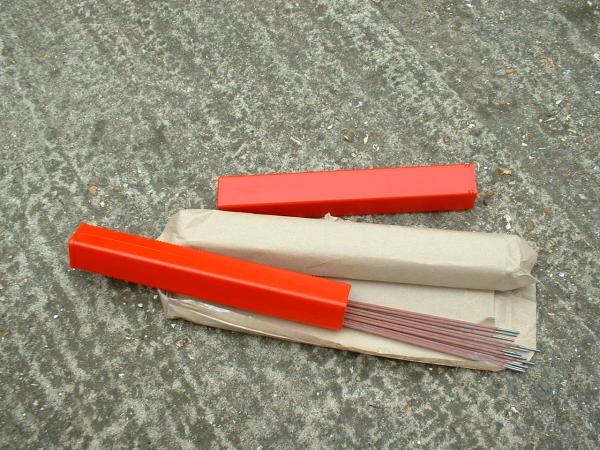

This note of June 5th - see later note for what I discovered... Anyway;
Heard of the legendary and slightly feared "Fleetwelds" and always
wanted to try them and if possible master their usage. This
complementary sample kindly sent by Lincoln Electric. These are the
defining current variant, the
The Lincoln website informs us that the "Fleetweld" family of
electrodes started with the
They have a fearsome reputation, as the predominantly cellulose content of their coating ("wood flour" (sawdust?), paper fibres, etc) decomposes in the arc creating huge quantities of hydrogen which causes high arc voltages and a constricted arc giving deep penetrating power. Meanwhile, the coating converted mainly to a gaseous shielding leaves little mineral slag, giving a fast-freezing weld metal and little slag, creating the opportunity for some unique specific-to-cellulosics welding techniques/applications.
In appearance, there is nothing which sets them apart from other "stick"/SMA electrodes. The maroon colour and the imprint "FW5" are the only warning :-)


Took electrodes to try at nearby college, where various welding machines and facilities to easily prepare plate. Obviously, feeling very excited, as "moment of truth" approaching. What a finding it turned out to be...
No welding machine I could find would run these rods, the
Hmmm.... Realised I was probably supposed to find something out here, and this was it...
So back to a certain company not wholely unconnected with these rods. "Oo arrhhh, there's reckoned to be only two types of machine which will run them. A diesel DC generator welding machine or a Lincoln Bullet. That's a three-phase motor spinning a DC dynamo." The diesel DC welding machine and the Lincoln Bullet amount to a statement that there is only one way to run these rods - to directly couple them across a DC welding generator.
These are proving to be some welding rods!
Final note to say, yes, I do know the "stovepipe" pipe-welding technique using cellulosics is regarded as something of a thing of the past. Apparently steel pipe strengths are higher, meaning thinner wall thicknesses, hence smaller more highly stressed welds where no part of the weld can undermatch the pipe for strength. This makes for hard weld metals and so on where the high hydrogen is really a problem. But has been interesting stuff to study.